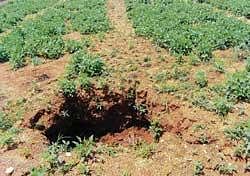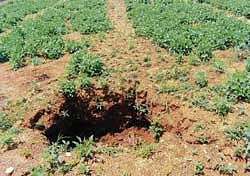

Farmers in the entire district are facing crisis due to shortage of water. The level of water in the borewells too has dropped drastically, adding to their woes. Under such circumstances, N R Chandrashekhar of Nenamanahalli has taken this step to ensure that not a single drop of rainwater goes waste.
Chandrashekhar grows multiple crops in his one acre-six gunta farm. He has dug siltation pits that are three feet in length, breadth and height, between the crops. The pits now have proved life-savers to the rain-deprived field.
Chandrashekhar’s farm has drawn the attention of everyone, being covered by such siltation pits and other utilitarian agricultural mechanism.
First step
Chandrashekhar has had a huge tank that is 70 feet long, 50 feet wide and12 feet deep, costing Rs 25 thousand, dug in a corner of his farm. Rainwater collects in the tank.
However, this alone was not enough for the crops. Therefore, Chandrashekhar had the siltation pits dug in his field. The labour to dig the pits too was provided by his family members.
The pits now contain cool water. The muds on walls of the pits have hardened. Although weeds grow in the area, Chandrashekhar says the plants rot in the pits, thereby providing free additional manure for the crops.
Practical measure
Speaking to the Deccan Herald on Saturday, Chandrashekhar said, “Every pit can hold upto 900 litres of water. There are 50 such pits, which means as much as 45 thousand litres of water can be collected in the farm. This adds to the moisture content in the land. It will also help prevent soil erosion.”
He added that even if there are instances of erosion, the soil will only collect in the pits. So, there will be no loss of earth.
“I have dug the pits in a way as to prevent danger to both land and the crops. Every drop of rainwater will remain within the farm. Also, even if we have an entire month without any rain, my crops will not dry up,” he said.
Chandrashekhar added that he has also sown horsegram. “The green covering of the crops will provide relief from acute sunlight. The leaves can be used as manure, thereby provide some amount of nourishment for the crops,” he explained.
Before the experiment
“I had initially grown only ragi on my field. During the pre-monsoon showers, I sowed gram. Since it has been mulched into the earth, the land is already nourished with six to eight tons of green manure,” said Chandrashekhar.
The fertility and moisture content in the land has increased. The horsegram crop will only increase them further, he added, with confidence.